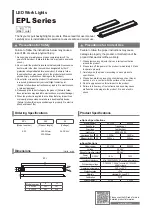
7
When using a power tool at a considerable distance from a power source, be sure to use an extension
cord that has the capacity to handle the current the product will draw. An undersized cord will cause a
drop in line voltage, resulting in overheating and loss of power. Use the chart to determine the minimum
wire size required in an extension cord. Only round jacketed cords listed by Underwriter’s Laboratories
(UL) should be used.
When working outdoors with a product , use an extension cord that is designed for outside use. This
type of cord is designated with “W-A” or “W” on the cord’s jacket. Before using any extension cord,
inspect it for loose or exposed wires and cut or worn insulation.
MINIMUM GAUGE FOR EXTENSION CORDS (AWG)
(WHEN USING 120 V ONLY)
Ampere Rating
Total Length of Cord in Feet (meters)
More Than
Not More Than 25' (7.6 m)
50' (15 m)
100' (30.4 m) 150' (45.7 m)
0
6
18
16
16
14
6
10
18
16
14
12
10
12
16
16
14
12
12
16
14
12
Not Recommended
Extension Cord – Make sure your extension cord is in good condition. When using an extension
cord, be sure to use one heavy enough to carry the current your product will draw. An undersized
extension cord will cause a drop in voltage resulting in loss of power and overheating. The table shows
the correct size to use depending on cord length and name plate ampere rating. If in doubt, use the next
heavier gauge. The smaller the gauge number, the heavier the cord. To reduce the risk of disconnection
of appliance cord from the extension cord during operating:
1. Make a knot as shown in Figure A. or
2. Use one of the plug-receptacle retaining straps or connectors.
ELECTRICAL
METHOD OF SECURING EXTENSION CORD
(A) THE CORD AS SHOWN
(B) CONNECT PLUG AND RECEPTACLE





























